
Updated: 03-


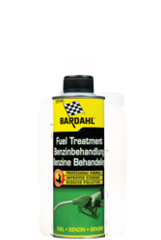 Denk aan Fuel treatment van Bardahl;
Denk aan Fuel treatment van Bardahl;
kijk op hun website voor de werking
en nog meer praktische producten voor
uw auto.
En HIER het pdf voor de werking
van Fuel Treatment
Some cars are being equipped with fuel cells which have many benefits. The plastic cells do not rust; they have foam in the bottom which eliminates fuel movement on cornering and they are much safer than galvanized tanks. These fuel cells are available in many shapes and sizes. Check your local parts house.
Fuel System
The fuel system in cars can create a lot of havoc and grief when neglected or left unattended for too long. Gasoline has a shelf life of 90 days. This means that if left for more than two years chances are that the fuel will go stale and will cause problems if fuel jells or gums up inside carburettors.
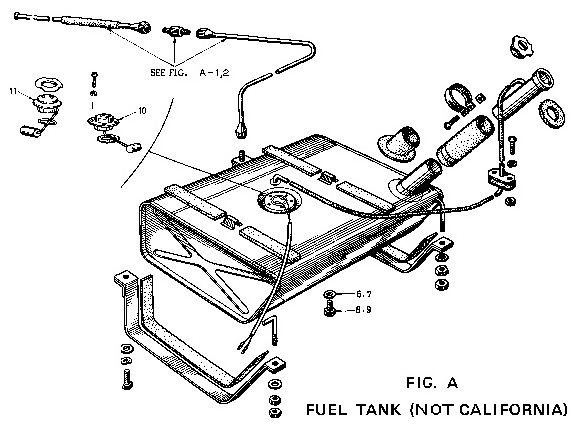
Moisture is another problem with cars that sit for extended periods; condensation inside your fuel tank will cause deterioration of the sending unit, the tank, and performance. There are fuel additives that envelope moisture and enable the moisture to be burnt; methyl hydrate is the most common and is used in cold weather places to prevent fuel from freezing.
There are also fuel conditioners that prevent fuel breakdown and control moisture and condensation build up.
To see whether or not your tank needs to be cleaned, check the fuel filter; is it continually getting clogged? The reason for this might be that you are running the tank low and the fuel pickup is sucking in all the sediment and accumulated garbage that has found its way into the tank. Open the trunk, remove the mat and find the gas sending unit plate; loosen at least three of the four philips head screws and you will expose the top of the tank where the sending unit sits.
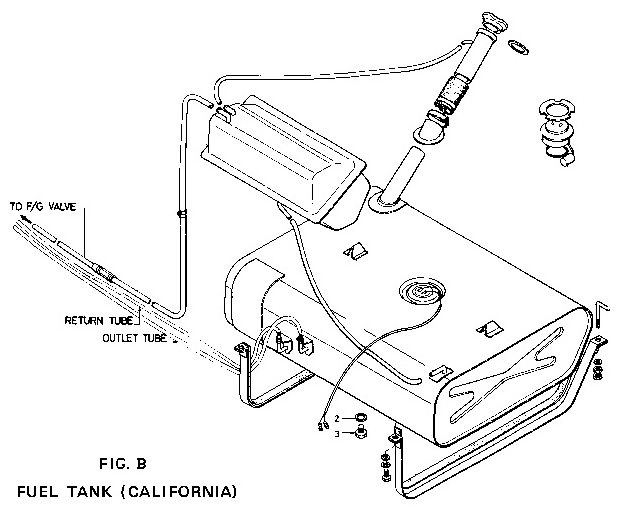
Get out the vacuüm cleaner and clean as much debris as possible out of the way before
attempting to extract the sending unit. There are two kinds of units in Datsun Roadsters.
The early type (see Figure A part marked #10) is held in place by screws, sometimes
slotted, sometimes philips. Once again, soaking in penetrating fluid will hopefully
loosen them; be patient. The later style unit (see Figure A part marked #11 for Non-
Once removed, you have a limited but good view of the inside of your tank. Is it shiny galvanized metal or is it covered in crud and rust? This is when you either decide you can flush the tank in place or that you have to to drop the tank.
Flushing in Place
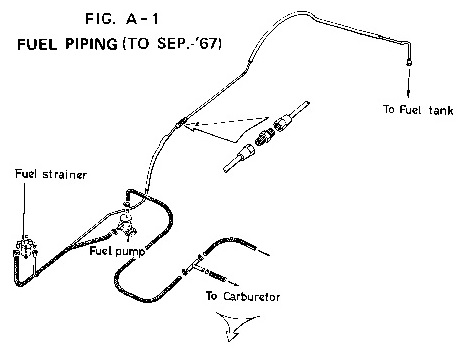
Blow all the fuel lines out with compressed air while there is still a small amount
of fuel perhaps half a gallon, left in the tank. Unhook the fuel line on the gas
tank side of the fuel filter (shown as "Fuel Strainer" in Figures A-
Removing the Fuel Tank
Removing the fuel tank can be easy provided that the tank is empty and the two strap hooks and rear nuts are soaked in penetrating fluid. You can empty the tank by removing the drain plug (shown as parts marked #8 or 9 in Figure A, and #3 in Figure B). Remove the fuel lines from the front of the tank before undoing the straps; By removing the front nuts and bolts you prevent damage to the straps and hooks. Be very careful not to twist the fuel lines as this will create some unwanted work; the straps have a tendency to get twisted when trying to loosen the hooks.
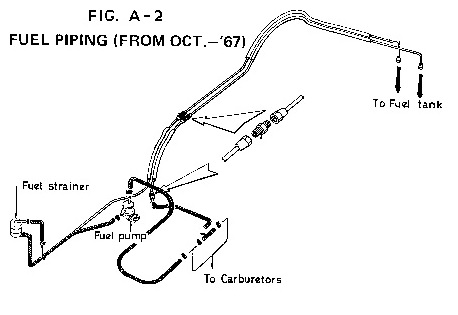
Once the tank has been removed, a good exterior and interior wash is recommended. Pressure washing and a good grease cutter have worked well in removing gummy build up and sediment. Corrosion and flaking rust can be neutralized with proper chemicals and even then can cause problems later on. We take them to the local radiator shop which boils the stripped unit and does a great clean up. Some customers have had coatings installed on the inside of the tanks but we have found that these coatings break down, gum up fuel lines and destroy floats, especially 1600 SU floats.
Over vlotters gesproken; Het beste is als u nog “koperen” vlotters heeft deze te vervangen voor plastic uitvoering. Deze gaan namelijk lekken waardoor ze allerlei problemen kunnen veroorzaken. De brandstofpomp heeft van binnen een membraam dat ook vervangen dient te worden, ook deze geeft problemen bij verouderde benzine. Vlotters zijn nog via de Nissandealer leverbaar.
General
The last three customers' cars that came to the shop all suffered from hesitation and stalling. All three had clogged fuel filters and needed to have the tanks flushed and cleaned. Such cars often sit for six months a year or more.
On two we installed the glass bowl filter to monitor the flow of sediment to ensure that all the debris had been removed. The nice feature of the glass bowl is that you can clean it and reuse it. The later style filter is a one time use that once contaminated has to be disposed of.
The only drawback with the glass bowl system is that the cork gasket has a tendency to dry out and has caused many people to wonder why the fuel is not reaching the carburettors; this gasket creates an air leak that sucks in air and hence does not allow the fuel to reach the carburettors.
Cars sitting for periods of over two months should use fuel conditioners that prevent fuel breakdown and control moisture and condensation build up. Parking the car with a full tank also minimizes internal tank deterioration.